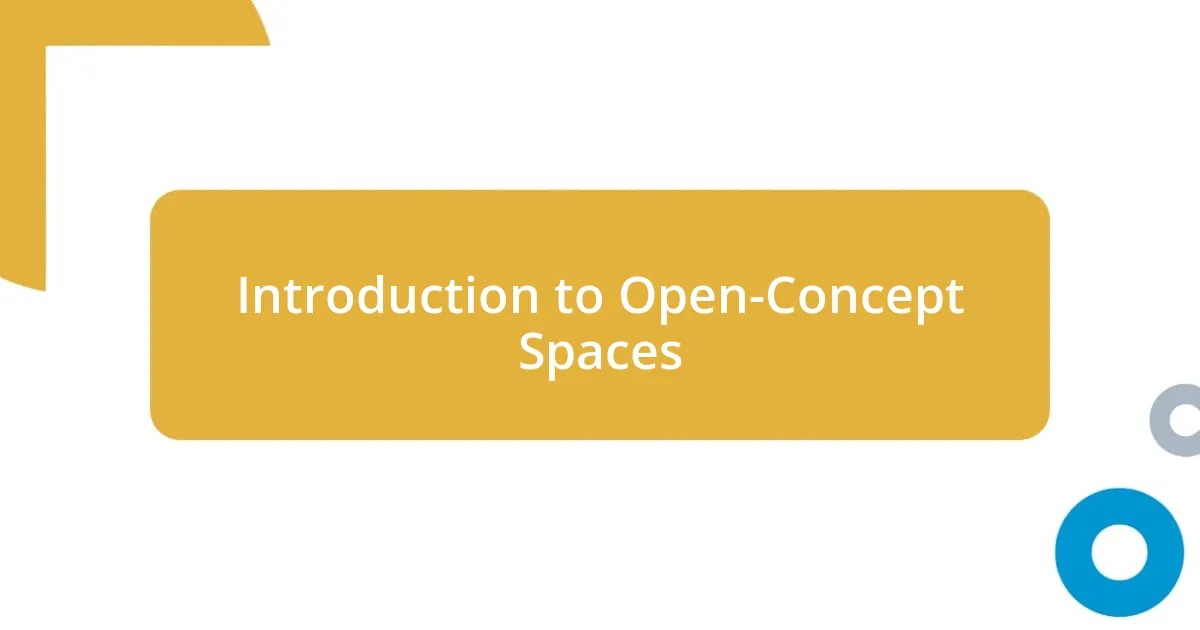Key takeaways:
- Open-concept spaces enhance social interaction, flexibility, and a sense of spaciousness, allowing for seamless transitions between areas.
- Key design principles include maximizing flow, natural light, and sound management while using defined zones to create distinct areas.
- Choosing the right layout and materials, along with personalized touches, elevates both functionality and emotional connection in a space.
- Creating functional zones through thoughtful furniture arrangements and decor can transform an open layout into cozy, inviting spaces without losing openness.

Introduction to Open-Concept Spaces
Open-concept spaces have dramatically transformed the way we think about our homes and workplaces. I’ll never forget the first time I walked into a beautifully designed open-concept area; the light flooded in, and the seamless flow from room to room felt liberating. It made me wonder: why didn’t I embrace this design sooner?
The essence of open-concept spaces lies in their ability to foster connection and collaboration. I remember hosting a dinner party in my own open kitchen-living area and how my guests mingled effortlessly, sharing stories and laughter as if the walls had simply vanished. Doesn’t that sound inviting? The absence of divisions can create a warm atmosphere that encourages interaction, making spaces feel larger and more inclusive.
However, while the allure of openness is captivating, there are practical considerations to weigh. From my experience, striking the right balance between aesthetic appeal and functionality is essential. How do you maintain privacy or quiet without walls to create boundaries? Through thoughtful design, such as strategic furniture placement or creative soundproofing solutions, it’s entirely possible to achieve the best of both worlds in an open-concept space.

Benefits of Open-Concept Design
Open-concept design offers a remarkable sense of space and light. I remember vividly when I first opened my living area to the kitchen. The abundant natural light seemed to uplift my spirits, making the whole environment feel vibrant and energetic. It’s incredible how removing walls can change not just the physical space but also the atmosphere.
Another significant benefit of this design is flexibility. In my own home, I discovered that my open space allowed for easy rearranging. Whether it was adapting my living area for a movie night or creating a different setup for family gatherings, the lack of rigid boundaries gave me options. Have you ever wished you could transform your space effortlessly? I surely have, and I found that with an open-concept layout, the possibilities are endless!
Lastly, the enhanced social interaction in open-concept spaces is unbeatable. Hosting friends became more of a bonding experience rather than a fragmented event. I could cook, laugh, and engage with everyone in the same breath—there’s something truly special about sharing these moments in a unified area. It’s a great reminder of the connections we forge when we allow our environments to be just as inviting as our interactions.
| Benefit | Personal Insight |
|---|---|
| Sense of Space | Natural light uplifted my spirits and made the environment feel energetic. |
| Flexibility | Rearranging my space for different activities became a simple joy, allowing endless possibilities. |
| Social Interaction | My gatherings turned into bonding experiences, as I could engage with everyone effortlessly. |

Key Principles of Open Spaces
The key principles of open spaces revolve around creating a sense of flow, enhancing natural light, and ensuring usable flexibility. I recall a pivotal moment while rearranging my furniture; as I shifted my couch closer to the adjoining dining area, I felt an instant connection with my other living spaces. It was as though the room breathed a sigh of relief, welcoming me into its expansive embrace.
Here are some essential principles to consider when designing open spaces:
- Flow: Maximize movement between areas, allowing for seamless transitions.
- Natural Light: Emphasize windows and skylights to keep spaces bright and energizing.
- Flexibility: Choose versatile furniture that can be easily adjusted to suit different activities.
- Defined Zones: Use rugs or subtle changes in floor materials to create distinct areas without physical walls.
- Sound Management: Incorporate materials that absorb sound to maintain a comfortable ambiance.
Focusing on these principles can elevate the overall experience of an open-concept space. I’ve noticed that incorporating functional elements not only enhances interaction but also fosters a sense of belonging among my family and friends. Each gathering felt more cohesive, and it reminded me of how open spaces can create beautiful experiences worth cherishing.

Choosing the Right Layout
Choosing the right layout for an open-concept space can feel daunting. I remember weighing the options between a more linear configuration versus a circular one. The moment I decided on a layout that encouraged flow and movement, it transformed my experience—guests naturally gravitated toward the kitchen while I prepped dinner, making it a shared moment rather than a solo chore.
One layout aspect I cannot stress enough is the importance of defined zones. When I added a stylish area rug under my dining table, it created a subtle boundary that distinguished where meals happen from the casual lounging area. This minor adjustment redefined how I perceived and utilized the space; it was as if I had discovered a magic trick for surfacing purpose in an open room. Hasn’t anyone else felt the power of a simple design choice to reorganize their experience?
Ultimately, I believe that embracing versatility is key when selecting the layout. I once experimented with flexible furniture options: a coffee table that could double as additional seating. It not only impressed my guests but also made my small gatherings feel more welcoming and connected. I’ve learned that the perfect layout isn’t about rigidity; it’s about creating an environment that shifts harmoniously with your needs.

Selecting Materials and Colors
Selecting materials and colors for an open-concept space is one of the most exciting aspects of the design process. I remember feeling exhilarated while curating a palette that reflected both my style and the atmosphere I wanted to create. Choosing soft neutrals for the walls, accented by vibrant colors in decor, helped evoke a sense of calm yet liveliness. How do the colors in your own space make you feel? I’ve always found that a well-chosen color scheme can either energize or soothe, depending on the mood I aim to establish.
When it comes to materials, I love the balance between practicality and aesthetics. For my living area, I opted for durable fabrics that withstand the occasional spill while still feeling luxurious. I vividly remember when my niece spilled her juice on the new sofa; instead of panic, I felt relief—thanks to the easy-to-clean material! It’s moments like those that make me value my choices deeply. In addition, selecting materials that reflect natural elements, like wood or stone, can offer a grounded earthy vibe, inviting nature indoors. Have you ever noticed how certain textures can alter the energy of a room?
I often advise blending different textures to add depth and visual interest. While shopping for a new coffee table, I found one that combined a rustic wooden base with a sleek glass top. It wasn’t just about functionality; it added a conversation piece to the room. I think that’s the beauty of open spaces—every material and color choice contributes to a larger narrative. What story do you want your space to tell? Each selection can enhance the overall atmosphere and evoke emotions, creating a harmonious environment that tells a unique story while serving your needs effortlessly.

Tips for Creating Functional Zones
Creating functional zones in an open-concept space isn’t just about physical dividers; it’s about intentionality in how you use the space. I found that using furniture arrangements to define areas—like placing a sofa at an angle—can effectively carve out a cozy reading nook. It amazed me how shifting a few pieces turned a vast area into distinct, inviting spaces without sacrificing the openness I love. Have you tried a bold move like this to see how it transforms your own environment?
In my journey, I discovered that lighting plays a crucial role in defining these functional zones as well. I recall installing two pendant lights over my kitchen island that not only highlighted that area but also created a warm ambiance for meal prep. It felt like casting a spotlight on creativity! Simple adjustments like this can make functional areas feel significant and purposeful.
A personal touch that worked wonders for me was incorporating plants to delineate spaces. I placed a tall plant near my home office area, immediately setting it apart from the rest of the room. It served a dual purpose; the greenery enhanced my focus while reminding me of nature. Have you noticed how the right decor not only beautifies but also delineates? Embracing these subtle strategies can enhance both functionality and comfort in your open layout.

Final Touches and Personalization
Final touches can make or break your open-concept space. I remember how I agonized over the choice of art for my walls. Adding a large, vibrant painting suddenly pulled the room together and became a focal point. It’s as if the space took a deep breath and exhaled all the right vibes! Have you ever felt that just by hanging a piece of art, the energy in a room shifts?
Personalization is where I find the heart of any space truly shines. When I displayed my collection of travel souvenirs, the room transformed from just a beautiful layout to a reflection of my journey and experiences. Each item tells a story; it’s not just decor, but a piece of my life. I believe that showcasing personal items fosters a deeper connection. What memories do you want to invite into your space?
Lastly, I love how incorporating personal touches, like custom throw pillows featuring family photos, turns any area into a comforting retreat. I once gifted a friend a handcrafted quilt made by my grandmother for her new home, and it instantly made her space feel cozier and more inviting. Personalized elements like this create warmth and make guests feel right at home. How have you experienced the power of personalization in your environment?














